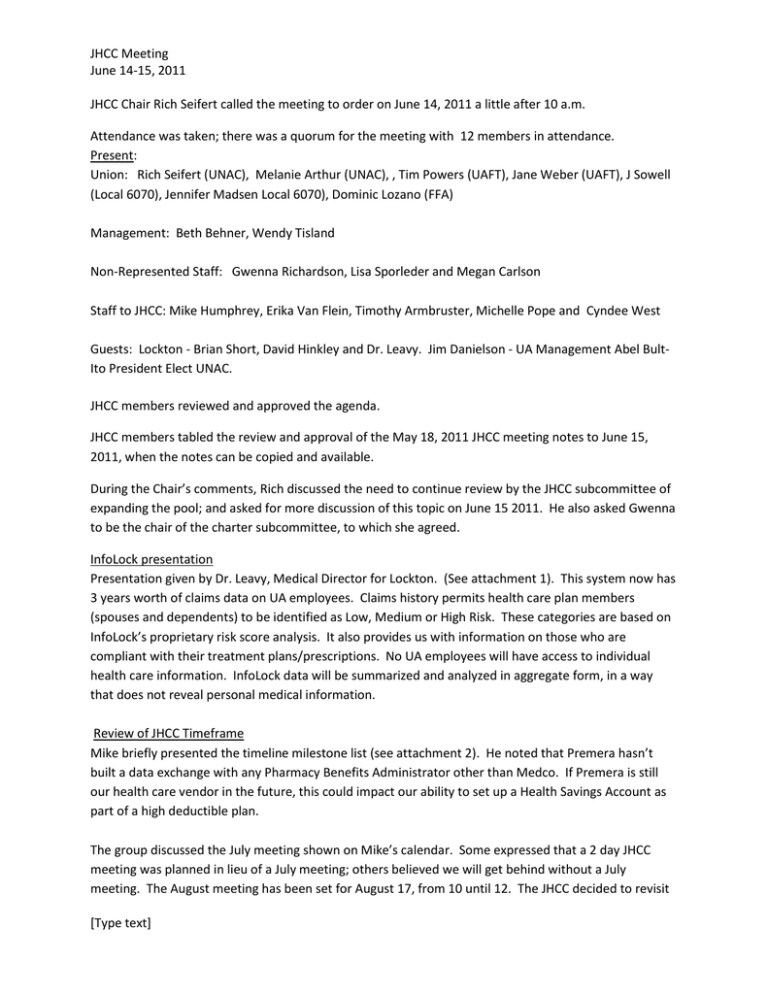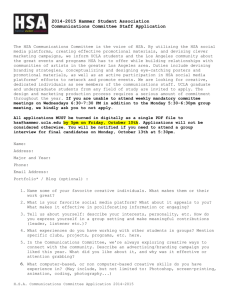JHCC Meeting June 14-15, 2011
advertisement

JHCC Meeting June 14-15, 2011 JHCC Chair Rich Seifert called the meeting to order on June 14, 2011 a little after 10 a.m. Attendance was taken; there was a quorum for the meeting with 12 members in attendance. Present: Union: Rich Seifert (UNAC), Melanie Arthur (UNAC), , Tim Powers (UAFT), Jane Weber (UAFT), J Sowell (Local 6070), Jennifer Madsen Local 6070), Dominic Lozano (FFA) Management: Beth Behner, Wendy Tisland Non-Represented Staff: Gwenna Richardson, Lisa Sporleder and Megan Carlson Staff to JHCC: Mike Humphrey, Erika Van Flein, Timothy Armbruster, Michelle Pope and Cyndee West Guests: Lockton - Brian Short, David Hinkley and Dr. Leavy. Jim Danielson - UA Management Abel BultIto President Elect UNAC. JHCC members reviewed and approved the agenda. JHCC members tabled the review and approval of the May 18, 2011 JHCC meeting notes to June 15, 2011, when the notes can be copied and available. During the Chair’s comments, Rich discussed the need to continue review by the JHCC subcommittee of expanding the pool; and asked for more discussion of this topic on June 15 2011. He also asked Gwenna to be the chair of the charter subcommittee, to which she agreed. InfoLock presentation Presentation given by Dr. Leavy, Medical Director for Lockton. (See attachment 1). This system now has 3 years worth of claims data on UA employees. Claims history permits health care plan members (spouses and dependents) to be identified as Low, Medium or High Risk. These categories are based on InfoLock’s proprietary risk score analysis. It also provides us with information on those who are compliant with their treatment plans/prescriptions. No UA employees will have access to individual health care information. InfoLock data will be summarized and analyzed in aggregate form, in a way that does not reveal personal medical information. Review of JHCC Timeframe Mike briefly presented the timeline milestone list (see attachment 2). He noted that Premera hasn’t built a data exchange with any Pharmacy Benefits Administrator other than Medco. If Premera is still our health care vendor in the future, this could impact our ability to set up a Health Savings Account as part of a high deductible plan. The group discussed the July meeting shown on Mike’s calendar. Some expressed that a 2 day JHCC meeting was planned in lieu of a July meeting; others believed we will get behind without a July meeting. The August meeting has been set for August 17, from 10 until 12. The JHCC decided to revisit [Type text] JHCC Meeting June 14-15, 2011 the topic of a July meeting during the June 15 meeting. Jenn Madsen asked when the group will schedule a regular series of meetings for the academic year; noting that advance planning helps members find available meeting time. Wellness and Initiatives David Hinkley (Lockton) gave a presentation on the Wellness Initiative (see attachment 3), with the focus on health care cost containment. Mike noted that we may be able to negotiate better rates for medical services now that we have more thorough claims information compiled. In the RFP process, we will be looking carefully at competitive proposals from hospitals, for example. JHCC members discussed views on whether health conscious employees should get a break on premiums. Changing the format of employee contributions is a big topic for the committee to discuss. Members noted that employees have expressed concerns regarding mandatory reporting of biometrics, although the information would be aggregated and no confidential information would be available to the University or health care committees about their personal biometrics. David emphasized that the goal is to keep health people healthy; even people with serious health conditions would be able to qualify for reductions in their employee charges, as there will be alternative standards to qualify for the reductions other than through biometrics. A differential rate structure would offer a choice to employees in whether to take the steps to qualify for discounts to their health care charges. WIN for Alaska could potentially collect the data and biometrics; WIN already does similar work as a part of the Get the Point Program. JHCC members discussed the tobacco surcharge; details still must be determined after JHCC discussion. The topic of a Tobacco Surcharge was moved to the June 15 2011 agenda. David Hinckley provided a handout on the HRA/HSA offerings (see attachment 4). The following issues were discussed: With an HRA, only an employer can direct money into the account. With an HSA, both the employer and an employee can contribute. An HRA could be used with any of the current UA plans; an HSA could only be used with a qualified high deductible health plan (HDHP). Plan design changes, e.g. to our pharmacy plan, would be needed to implement an HSA. The pharmacy benefit administrator and our health care claims administrator would need to have the ability to easily and timely transfer data. Additionally, the pharmacy benefit would have to have a deductible if we implemented an HSA. This would impact quite a few people who use prescription drugs. An HSA only permits access to money already deposited, similar to the format of a flexible spending account for dependent care. In contrast, HRAs can pay for costs up front. For an HSA, you can’t be enrolled as a dependent on another plan. The rule is “No first dollar coverage.” Eligibility for secondary coverage will not prohibit someone from having an HSA. [Type text] JHCC Meeting June 14-15, 2011 Also, a person can’t be double covered unless both individuals have HSAs, if the employer makes the HSA contribution. (An employee’s money can be used for dependent coverage; it is just the employer contribution that is restricted.) The JHCC discussed where funds could come from for setting up an HRA/HSA. Private employers may choose to front load funds into these accounts that would be spent elsewhere for health care. Nothing is negotiated between UA and its unions for front loading money into these types of accounts at this time. Self funding of HSAs is always a possibility, and some employees might choose to do this as they would receive tax benefits and could carry funds over from year to year. It was also noted that an HDHP can be offered either with or without an HSA. Currently, UA has a qualifying HDHP, but has not established HSA or HRA accounts. Jenn moved to review Open Enrollment selection data and analyze the HSA option after that; postponing implementation of an HSA account to no sooner than FY14. It was noted that we will need to analyze how many employees selected the HDHC plan; this may help us estimate the number of individuals who may be interested in setting up an HSA. A delay will allow more time for communicating needed information and explanations to employees concerning these accounts, as well as setting up this type of program. Tim seconded. Motion carried. A brief update was provided on the dependent audit. The employees who have not responded or fully verified their dependents have a total of over 250 dependents. This is a 96% response rate. More details will be provided as SWHR reviews these situations on a case by case basis. A list of employees’ names will be provided to union presidents so they can assist in contacting employees in their units. Gwenna provided an update that Ketchikan submitted a request for use of wellness incentive funds. Employees were appreciative of the opportunity to apply for incentive funds. Meeting adjourned at approximately 5:05 p.m. [Type text]
